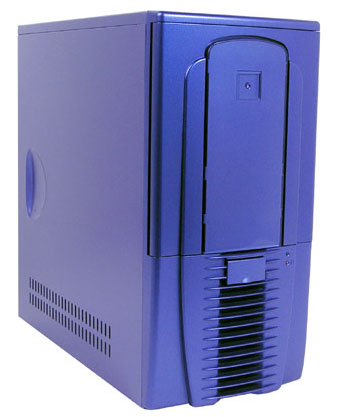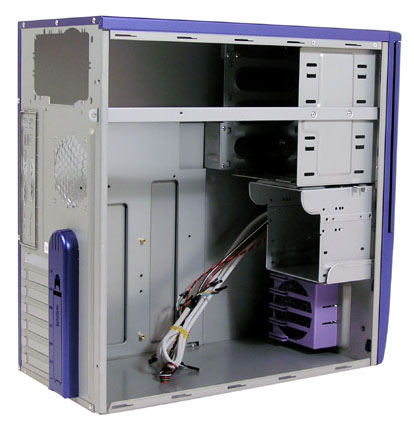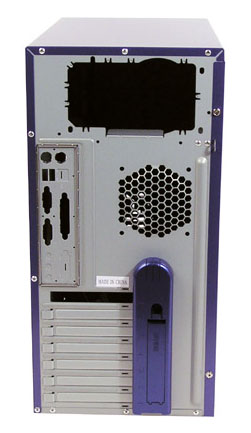Value Case Roundup: A Look at the Affordable
by Purav Sanghani on February 1, 2005 12:35 AM EST- Posted in
- Cases/Cooling/PSUs
Chenming 301KEBL
Chenming has been manufacturing PC cases for over 20 years. They have an extensive background in the sheet metal business and it shows in each of their products. Today, they are one of the largest OEM companies in the case industry and continue to offer their products and services around the globe. We had to include a Chenming case in our roundup and we chose the 301KEBL, which is based on Chenming's ATX-301KB design.
External Design
Chenming's trademark look has been implemented into the 301KEBL as it has been in many of their other products. The bezel features a door that opens out to the left to expose the four 5-1/4"; drive bays and two 3-1/2"; drive bays. The power and reset buttons are also hidden away behind the door to the right of the 3-1/2"; bays. A small, but useful, feature is the easy-to-remove drive bay covers that can be pulled off directly from the front of the case.

The bottom section of the bezel consists of the vents similar to the other cases in Chenming's product line. At the top of this section is a small fold-up door that hides two USB and one FireWire port. A quick glance may have us believe that there is nothing there, though. To the right of this door are the power and HDD activity lights.

The side panels are bare except for two rows of vents at the bottom of the panels. Each panel can be removed easily to get to the inside.
Internal Design
The inside of the 301KEBL was something that we weren't expecting at all. Along with the standard four 5-1/4"; drive bays, there was a removable drive cage, which could fit up to four 3-1/2"; drives, two of them exposed. To remove this drive cage, we pushed the small lever back and pulled the drive cage back to remove it. This will certainly help install drives when screwing them in from both sides.

The motherboard tray accepts microATX and full ATX motherboards as the others do. Using standard stand-offs included with the case, we can mount our test board as well as various other boards into the 301KEBL.

The expansion slots also have a feature similar to that on Foxconn's TK-09. The expansion slot mounts protrude out the back of the case and are covered by a blue plastic casing. This casing also houses extra screws to keep them in a handy place. To remove this casing, we push the stopper down from the inside and pull the plastic piece off from the back of the chassis.











58 Comments
View All Comments
DAPUNISHER - Tuesday, February 1, 2005 - link
http://www.newegg.com/app/ViewProductDesc.asp?desc...Has side and top fans included and goes for $31. Also has room for 1 intake and 2 exhaust and good conservative styling.
DaveA - Tuesday, February 1, 2005 - link
oh and the athenatech a602 goes for $48.50 on newegg. i recommend it over any of the cases reviewed here.DaveA - Tuesday, February 1, 2005 - link
how come you didnt include the athenatech a602? you recommended it in your recent budget guide. it has 120mm fan slots in the front and rear of the case, a 92mm cpu duct on the side of the case which can take a 92mm fan. it has 2 usb 2.0 ports on the front along with microphone and speaker ports. its almost completely tooless as well. has a removable hard drive cage and no sharp edges.Spacecomber - Tuesday, February 1, 2005 - link
I don't think that I can see making use of any but a couple of these cases reviewed, even for an inexpensive system. I mean there's inexpensive and then there's cheap, and most of these cases exude cheapness. For instance, I can't believe that a few drilled out holes in sheet metal can provide a proper fan vent; it looks more like what you would use for straining your spaghetti noodles.I guess that I'm also not of the school that screwless is better. I mean operating a screwdriver is pretty simple; often more so than trying to figure out how all the various clips and latches are suppose to work. I usually end up feeling like a system that uses screws, instead of these various clips, is really assembled and not just hung together.
So far, I haven't found a case and power supply (bought seperately or together) that is as good as and less expensive than the Antec 1650, which is my choice for entry level and basic systems. $55 for a case that includes 120mm fan, Antec SL-350 power supply, and side CPU air guide.
Antec just needs to start upgrading their power supplies to more models with 24 pin main power cables and 6 pin PCI-E video card connectors, but I'm talking about their cases and power supplies aimed at higher end systems, now.
Anyway, that's just my 2 cents worth. I always enjoy looking at any review that tries to focus on practical hardware such as this review does.
Space
sdfg - Tuesday, February 1, 2005 - link
Actually, the Chenming case looks very similar to the Antec Lanboy, only steel and sans power supply.LoneWolf15 - Tuesday, February 1, 2005 - link
The power supplies of these review units are horrible, and do not in any way represent good additional value, IMO. Every enthusiast forum I know of rates RaidMax and Powmax PSU's as utter crap. I noticed that at least one of them only delivered 12 amps on the 12v rail, not even close to what Barton core Athlon XP systems need for reasonable stability. I'm not sure I even trust the ratings on the stickers though, as cheap power supplies tend to list overly optimistic specs.For not much more than this, you can buy an Antec SX630II or SX635II case that may not be flashy, but is built more solidly, won't cut you, and has an Antec power supply. If you're serious about making a good system though, buy your power supply separately from the case. With cases, you really do get what you pay for, and the Chenming was the only case I saw in this review that I didn't think was crap.
MrEMan - Tuesday, February 1, 2005 - link
What is it these days with all the cases being mini/mid/full size towers? Unless you put the tower under the desk, it takes up more desktop real estate than putting the monitor on top of a desktop case (which also raises the monitor to eye level, which is preferred, unless the user has bi-focals).I don't want a tower and I don't want an XPC.
I want a standard desktop case with multiple bay options which can hold either a 19" monitor or a flat panel (neither of which an XPC will do apart from a balancing act).
Besides, since heat rises, vertical orientated expansion slots are better than the heat accumulating horizontal orientated slots in all tower cases.
avijay - Tuesday, February 1, 2005 - link
Good review. Its sad to note though for cases with a PSU, the PSU doesn't get much coverage despite requests everytime a case review is published. No indication of the reliability of the PSU that comes along with the case. Usually everyone who goes looking for a case would like to buy one with a PSU if available and it would be good to know the pros and cons of PSUs and also how they perform. Everyone knows a good PSU is as important for a stable system as any of the components. I'd really like to see how these PSUs (and for that matter some of the other well known PSUs) perform when put to the test.Possible to do a PSU roundup? If PSUs cant be covered in case reviews, please cover them separately.
Dranzerk - Tuesday, February 1, 2005 - link
I would rather buy one of these than all the stupid expensive voltron looking "gamer" cases on the market. I saw a case that looked like someone puked up crayons they ate all over it..it was $90! lolNice article.
eetnoyer - Tuesday, February 1, 2005 - link
Still waiting on the "affordable" memory review.